An electric bike rode into the backcountry. Now there's a nationwide turf war
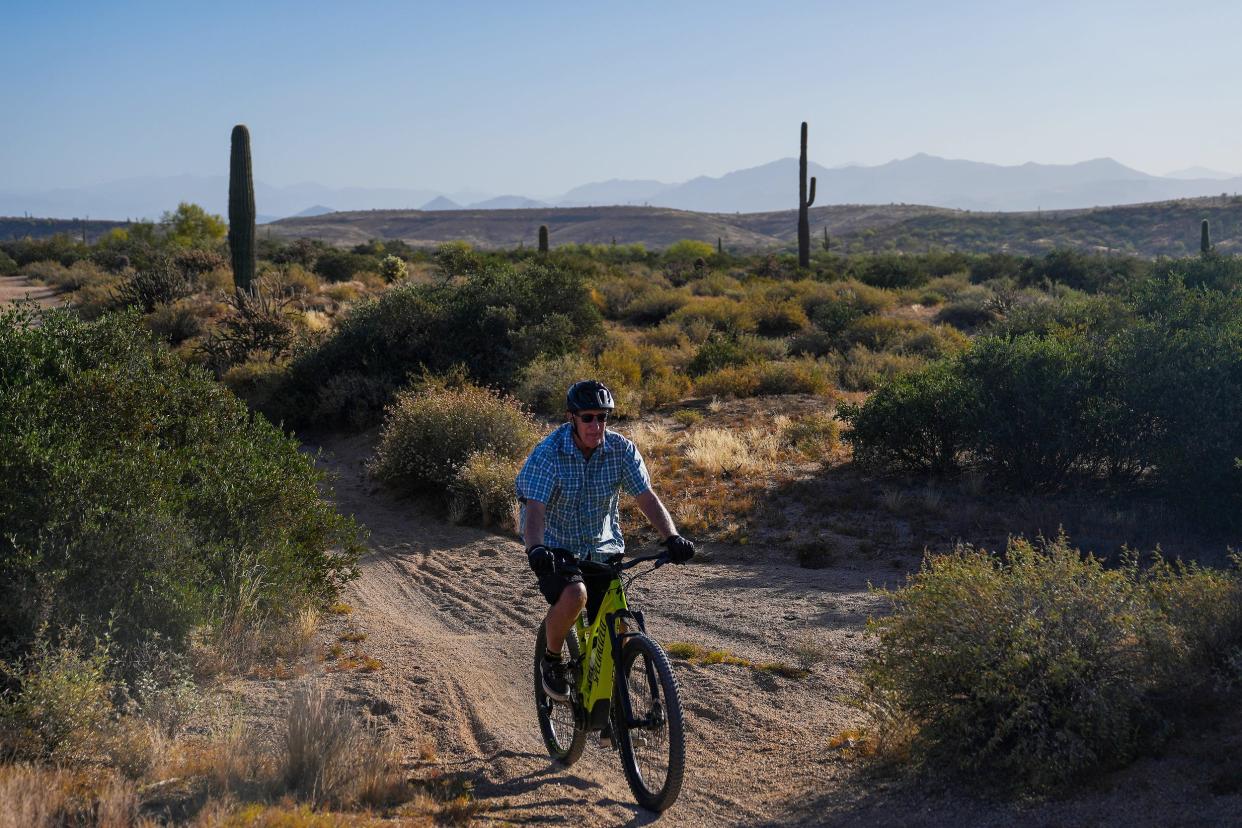
FOUNTAIN HILLS, Ariz. – A gray-haired dude jumped on his mountain bike and began pedaling into the Sonoran Desert along a rocky, single-track path.
The trail at McDowell Mountain Regional Park wound past towering saguaros, around paloverde trees in blooming splendor and through sand-filled arroyos. There was no sound except the grind of tires on gravel, the gush of a May breeze and the occasional call of sentinel quail.
Mile after mile, the ride seemed easy. Even as he climbed steep hills, 73-year-old Rand Hubbell barely broke a sweat. In fact, thanks to the bike’s inconspicuous electric motor, his ascent was relatively effortless: Hubbell could remain seated while a 750-watt battery let him use as much or little leg power as he chose.
Electric mountain bikes, known as eMTBs, are more than just welcomed in this 21,000-acre playground; they’re encouraged. The county park’s 40 miles of trails include specialized tracks for competition, plus rest stops with air pumps and spare inner tubes. More than half of the visitors are cyclists. A plaque at one canopy urges, "Of all the paths you take in life, make sure some of them are dirt."
The McDowell Sonoran Preserve shares a border with the regional park. It, too, is laced with miles of hiking trails.
Yet the preserve has a giant sign at its entrances featuring a picture of an e-bike with a slash through it: “Electric Bikes Prohibited.” It is run by neighboring Scottsdale, where a municipal ordinance bans battery-powered bicycles on all 225 miles of trails.
Adjacent properties. Opposite policies.
Adding to the confusion, numerous trails from the county park lead over the mountain crest and into the preserve's no-eMTB zone.
The two grounds might as well be a symbol for the turf war that has emerged with the infusion of electric mountain bikes into America's backcountry.
Over the past five years, smaller and stronger batteries have powered a booming market for electric bikes, or e-bikes, of all kinds. And, especially since COVID-19 lockdowns, backcountry trails have seen a proliferation of the dirt-ready variety.
While there is only partial data on the phenomenon, experts agree that cycling has skyrocketed, with electric mountain bikes the most popular model. Bicycle shops nationwide ran out of inventory during the past two years, with prospective buyers on monthslong wait lists. The trend is so powerful that Scottsdale bike salesman Jeff Frost jokes about eMTBs as cycling’s “gateway drug.”
According to PeopleForBikes, an advocacy organization for manufacturers, suppliers and cyclists, electric mountain bike sales increased by 1,000% from 2015 to 2019. LEVA, another analyst, reported more e-bikes were sold in the United States last year than electric cars. Mordor Intelligence predicts the worldwide market for battery-powered mountain bikes, valued at $5 billion in 2020, will double by 2026.
The onslaught of motor-assisted cyclists has generated a surge of traffic not only on streets, but on trails revered for serenity – trails where, often, motorized vehicles have been considered off-limits.
Thus began the turf wars.
When U.S. Forest Service managers tried to open trails near Lake Tahoe to e-bikes three years ago, the agency wound up in court – sued by the National Horsemen’s Association.
When the Department of the Interior announced that eMTBs would be treated as nonmotorized vehicles and allowed on trails in national parks, government employees filed another lawsuit.
In Utah, America’s mecca for mountain biking, state lawmakers tried to devise a statute this year that would clarify rules on e-bikes and single-track trails. The proposal got battered from all sides, said state Sen. Todd Weiler, who introduced the measure. Laughing, he described what followed as a "show," but with an unprintable adjective.
“My lesson?" Weiler said. "Don’t run an electric bike bill ever again.”
On Mackinac Island in Michigan, e-bikes are banned unless a rider has what's known as a "mobility disability" – a medical condition – or an inability to walk more than 200 feet without stopping.
Back in Scottsdale, when city staffers suggested last year that the Sonoran Preserve might open some trails to e-bikers, conservationists stormed social media and bombarded City Hall with email, most of them rabidly opposed to any motorized traffic in the parklands.
The proposal was promptly tabled, and no one has dared bring it up since. “It’s a very passionate discussion,” observed Scott Hamilton, manager of the preserve.
During a rest stop, Hubbell mentioned that in 1998 he helped write the city ordinance banning motorized vehicles from the preserve. Later, he served on a commission overseeing its trails. And from 2003 to 2015, he was supervisor of the adjoining county park.
Hubbell said he became an avid mountain biker after retirement. But age and health issues took a toll until the morning rides just sapped his strength: “My wife’s list of to-dos didn’t get done.”
That’s when Hubbell started noticing e-bikes as they passed him on hill climbs, sometimes with older riders. “I thought, ‘That’s pretty cool,’” he recalls. “I’m working hard and these guys are going right by me. And they’re smiling.”
Text with the USA TODAY newsroom about the day’s biggest stories. Sign up for our subscriber-only texting experience.
'Trail punks'
Manufacturers, vendors, riders and other advocates insist that, while eMTBs have motors, they are really just bicycles.
They contend electric bike ownership is dominated by older people who travel slower, with less danger and trail damage. And the battery allows disabled or weak riders to enjoy the great outdoors while getting moderate exercise.
Those who oppose e-bike access to single-track trails include not just environmentalists and hikers, but equestrians and others who argue that eMTBs are faster, heavier, more dangerous and more destructive than regular mountain bikes. The motor also transports cyclists deeper into the outback, with increased impact on nature.
“It’s alarming people because it goes against why some of these places were set aside and protected,” noted the late John Freemuth, a Boise State University land policy expert. “There’s obviously a place for e-bikes… But there are places, perhaps, where they shouldn’t be allowed because other people go to national parks for experiences that don’t include whipping around on bikes at 20 mph.”
Some of the fiercest eMTB critics are regular mountain bikers – young purists who view the battery boost as “cheating.”
A 2020 article in Gear Patrol pointed out that mountain biking had once been the “drunk uncle” of outdoor activities, with riders disdained as “trail punks” by hikers, conservationists and horsemen.
After decades of diplomacy and trail-building, regular mountain bikes gradually gained acceptance. “But here we are again,” the article noted, "only now e-bikers are the pariahs."
In Washington state, the Evergreen Mountain Bike Alliance lobbied for a bill prohibiting eMTBs from all “natural surface trails.” The reason, as explained in Singletracks magazine, was a fear that if e-bikes are permitted, then land managers might close trails to all bicycles.
Amid the sound and fury, government officials have concocted a chaos of rules and policies from Alaska to Florida, with neighboring Arizona properties as classic examples.
The regulations and enforcement are so confusing, so inconsistent that even vendors warn customers not to purchase electric mountain bikes until they’ve checked with city, county, state and federal land agencies to learn whether they’ll have places to ride.
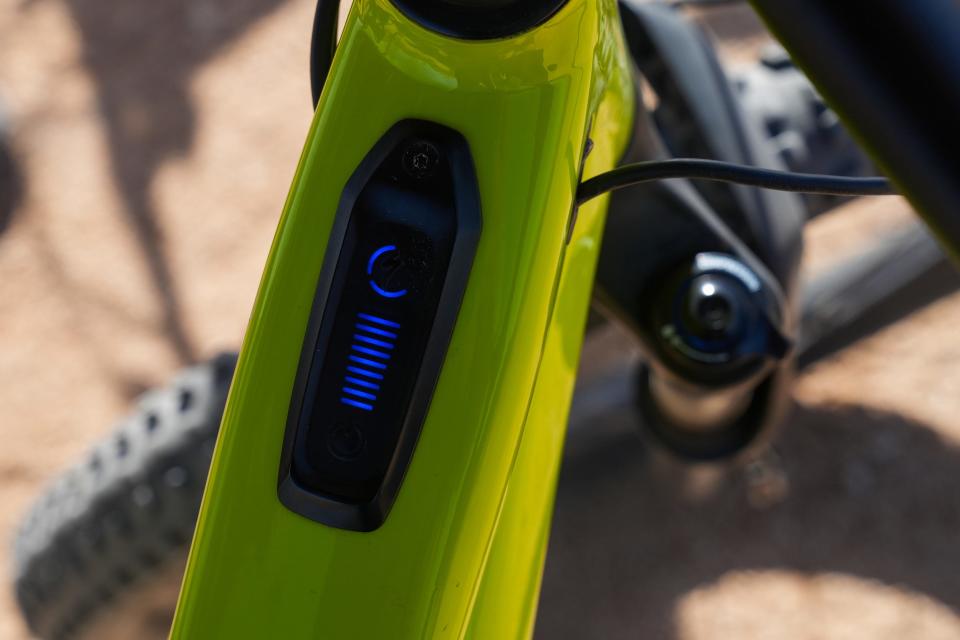
What is an eMTB?
In one sense, the dilemma is like any conflict that arises with disruptive technology: A new product or invention encroaches, prompting backlash.
Years ago, snowboarders fought for access to ski slopes. Today, drone operators struggle with flight regulations aimed at protecting privacy and public safety.
But eMTBs are particularly fraught because the technology places them in a gray area. Are they motorized vehicles or bicycles?
The dispute has churned up a mini-culture war. Bicycles were invented in 1817 but did not gain popularity until the 1890s invention of pneumatic tires allowed for a less bouncy ride.
As women began cycling during the Victorian era, wearing modified bloomers, bikes became a symbol of liberation. Anti-feminists of the day promulgated claims that the two-wheel contraptions made females walk funny, endangered reproductive ability and even caused a condition known as “bicycle face."
The first electric bikes also were patented in the 1890s. But, for a variety of reasons, they did not catch on until more than a century later.
Today, e-bikes are ubiquitous in Europe and Asia both as commuter vehicles and outdoor toys. The United States is playing catch-up, especially with knobby-tired mountain bikes.
The modern version features a motor that either assists a rider in pedaling or can provide all the power. Most jurisdictions set a 750-watt limit to the battery and recognize three levels of eMTB:
Class 1: The motor kicks in only when the bike is being pedaled, and a governor caps battery-enhanced speed at 20 mph.
Class 2: A rider can rely fully on the motor, without pedaling. The top speed under battery power is also 20 mph.
Class 3: The motor delivers energy only when the cyclist is pedaling and only up to a speed of 28 mph. (With wide support from industry groups and cycling advocates, Class 3 bikes are generally banned from natural, one-track trails.)
The e-bike is a techno nerd’s dream, with multiple motor types and software systems. But all draw power from a rechargeable battery that turns a shaft, creating torque that propels a wheel.
Because those mechanics are so small, with batteries concealed in the frame, many e-MTBs are nearly impossible to visually distinguish from regular bikes.
At the road racing world championships in 2016, cyclist Femke Van den Driessche was suspended for six years after magnetic imaging detected a battery-powered motor on her bike. Today, the Union Cycliste Internationale and some mountain biking race organizers routinely check for what’s known as “motor doping.”
But there’s another x-factor with eMTBs: The governor, which is supposed to limit a bicycle’s speed, can be hacked and overcome with apps that are available at local cycling shops and online. That means the maximum speed may be phony.
"The after-market hacks for eMTBs these days are unbelievable. It’s a booming business,” said Frost, who works in an Arizona bike shop. “There’s nothing illegal about it — until you see one go by at 35 mph.”
Anyone who has ridden a nonmotorized mountain bike on steep trails knows the sport is demanding, limited to riders in physical shape. Electric motors can dramatically reduce that stress, letting riders decide how hard they want to work during climbs — a godsend to those who have health conditions or limited ambition.
Of course, that advantage comes with a price: eMTBs start at around $1,000 for a hefty model with relatively cheap materials and parts, soaring to upward of $15,000 for a premium ride.
Legislatures and agencies around the country have struggled to define and regulate eMTBs. Most states have designated Class 1 and 2 bikes as nonmotorized, but often with confusing exceptions.
Even cycling organizations seem conflicted, caught between members who bristle at e-bikes and those who love them. The International Mountain Biking Association’s policy position is noncommittal, supporting Class 1 electric bikes in the backcountry unless that means traditional bikes will be banned.
“We want to see eMTB access granted,” said Todd Keller, the association’s director of governmental affairs, “but it has to be in a responsible way.”
PeopleForBikes, which represents manufacturers and suppliers, touts a model policy that presumes eMBTs may use trails open to regular bikes – except where prohibited or restricted in the interest of safety.
The state level: E-bikes in Utah
If Scottsdale’s adjoining parks epitomize local conflicts over trail use, Utah has emerged as a fascinating study at the state level.
This year, Weiler sponsored legislation he thought would simplify the rules, at least on nonfederal lands. One proposed change would have reduced allowable power for e-bikes while allowing them almost everywhere regular mountain bikes can go.
As Weiler tells it, manufacturers and retailers went bonkers over the reduction in battery power. So did hunters, who use eMTBs with trailers to transport their gear and game in the backcountry, and rely on 750 watts to pull those heavy loads.
Weiler said he started trying to tweak the bill, but every change stirred up new opposition. Amputees objected to a ban on e-bikes with throttles. County officials were outraged that the law would take away local control and warned that eMTBs in conservation areas would spur civil suits.
And all of that was heaped atop opposition from environmentalists, Weiler said, plus regular mountain bikers — “the purists who say if you don’t work out five hours a day you shouldn’t be out there.”
Jenn Oxborrow, executive director at Bike Utah, a nonprofit advocacy group for cycling, described other aspects of the backlash in almost comical terms.
Plans to create a permit system so anyone could be exempt from e-bike bans – even those not legally disabled – riled up the disability community by encroaching on their legal protections.
Meanwhile, search-and-rescue workers warned that electric bikes would put feeble people deep into the wilds where batteries would die or riders would suffer medical emergencies. Native Americans also were upset, envisioning motorized bikes rolling over sacred sites.
“I kicked a hornet’s nest,” Weiler acknowledged. “Everyone hated the bill. It was cursed.”
Weiler punted the legislation to Rep. Jeff Stenquist, who came up with new guidelines and convened a public hearing, which churned up more resistance.
Eventually, lawmakers adopted legislation that Oxborrow politely describes as a “suggestion,” urging land managers to consider e-bikes when developing trails.
Weiler offers a more candid appraisal: “We ended up passing a nothing burger bill.”
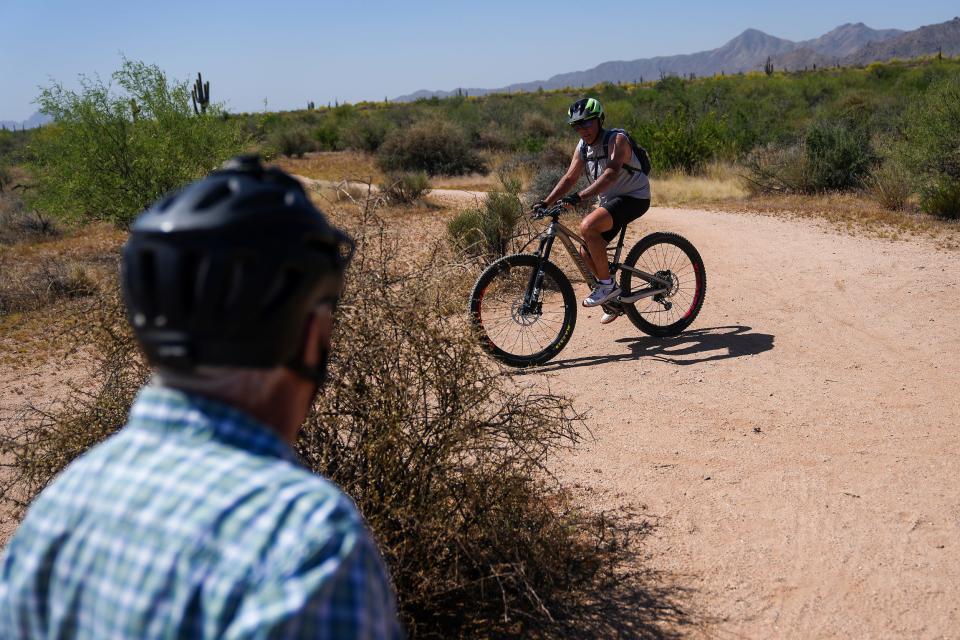
'You're made to feel like an outlaw'
A few years ago, after a couple heart attacks, Steve Spiro of Orange County, California, bought his first electric mountain bike. He gets a workout using pedal power until it’s too tough, then lets the battery help out.
“It’s important that I stay active,” said Spiro, a 64-year-old real estate agent, “but not to a point of over-exertion.”
However, as Spiro began taking his mountain bike to public trails, he kept getting turned away by signs and rules banning the electric motor. It was infuriating, he said: “You’ve paid your taxes, and then you’re made to feel like an outlaw or criminal – for riding your bike!”
Spiro discovered there is no consistency in regulations and concluded that policy differences are often arbitrary.
“These land managers are willy-nilly just making determinations,” he groused. For example, Spiro said, although the Americans Disabilities Act requires accommodations for the disabled, there is no standard for applying that to electric bikes.
“They will intimidate you and tell you to leave,” Spiro said of park rangers. “I’ve been threatened (with citations). I’ve had them yell at me, ‘Get out of here!’”
Spiro said he came to realize that trail policies are based largely on politics, with the loudest voices winning. In many cases, he added, that’s horsemen, hikers, environmentalists and regular mountain bikers.
Spiro decided to fight back, creating the Electric Mountain Bike Association to rally geriatric rides. A third of the U.S. population is 50 or older, he reasoned, and banning e-bikes amounts to elderly discrimination.
“My riding buddy Stanley Ramsey is a retired police officer and he is 82 years old,” says Spiro’s online petition. “E-bikes are a new technology that allows older citizens like myself and Stanley to ride a bike again by providing low-power pedal assist. The potential health benefits are enormous. … The Future is eMTB.”
About 5,000 have signed so far. Meanwhile, Spiro offers them “mobility disability” labels that can be attached to e-bikes. The stickers have no legal weight, and he doesn’t check whether applicants qualify as disabled under the law.
The goal is to help riders avoid citations. “It’s nothing official,” Spiro acknowledged, chuckling. “They are more, um, educational.”
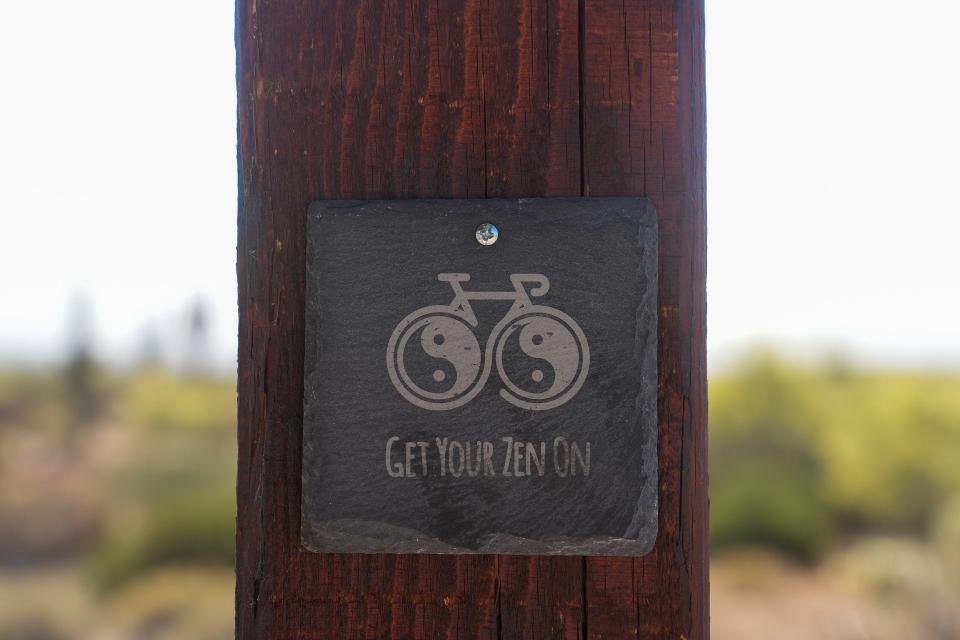
Why do people hate eMTBs?
Internal combustion engines are banned from single-track trails in the outback, in part because the engine noise messes with wildlife and destroys solitude.
An e-bike’s power train is virtually silent. So, from an environmental standpoint, there are only a few differences from a regular mountain bike.
The first is that eMTBs can put far more people into wild places and take them much deeper. To date, there are almost no studies on how that affects habitat.
The second difference is the potential for a heavier, faster machine to cause trail damage. Once again, there is little research to go by. The International Mountain Bike Association performed a test years ago, concluding that trail impact from e-bikes is not significantly greater than from non-motorized bikes.
But critics point out that the study involved just one trail and was conducted by an organization that promotes cycling.
Randy Rasmussen, director of public lands and recreation for Back Country Horsemen of America, said single-track trails are not designed for motorized use, and the notion that e-bikes won’t damage them is a “myth.”
Rasmussen added that, on uphill climbs, e-bikes are likely to spook horses from behind, endangering animals and riders.
“Horsemen and women are very alarmed by the advent of motorized bicycles,” he added. “They’re just clearly a safety concern.”
Equestrians also resisted regular mountain bikes years ago, Rasmussen acknowledged, before the two groups arrived at a “happy peace,” even collaborating on trail maintenance and development. However, he stressed, any bike with a motor represents “a different qualitative argument,” which could open the door to motorcycles on backcountry paths.
“We are worried about the slippery slope here,” said Rasmussen. “There’s a blurring of lines already.”
That fear is not as far-fetched as it might seem. When the BLM sought input on a policy for off-highway vehicles, the Capital Trail Vehicle Association submitted numerous suggestions. Among them:
“Electric motorcycles and electric mountain bikes are here and will completely take the sound issue off the table. This planning action must adequately accommodate the future use of electric motorcycles and mountain bikes on all existing single-track trails as a reasonably foreseeable development.”
And then came the lawsuits
If local and state officials ignited controversies over eMTBs, federal authorities in the Trump administration poured fuel on those flames.
In 2019, without public hearings or discussion, Secretary of the Interior David Bernhardt announced that electric bikes would no longer be treated as motorized vehicles and could use all trails open to regular bicycles on Interior land. That includes 419 national parks and recreation areas, plus millions of acres overseen by the Bureau of Land Management.
A day later, acting National Park Service Deputy Director P. Daniel Smith echoed that decision in an edict to all park superintendents.
A Colorado Sun report described the directive as “one of the most controversial rules in years for the Bureau of Land Management.”
The public backlash prompted some 24,000 emails and letters to the Park Service from groups and individuals.
The American Hiking Society reaction was aghast, declaring an official position that “any vehicle that uses either an internal combustion engine or an electric motor for propulsion is a motor vehicle.”
Within months, Public Employees for Environmental Responsibility filed suit, identifying 28 National Park Service venues that already were allowing electric bikes on trails set aside for nonmotorized travel. Among them: Everglades, Glacier, and Rocky Mountain national parks.
Peter Jenkins, an attorney with the employee organization, said the Park Service’s policy decision in 2019 was spurred by recommendations from an E-Bike Partner & Agency Group. The civil complaint alleges the meetings were conducted in secret and the “illegal committee” was loaded with cycling industry representatives, including PeopleForBikes.
Wilderness Watch and other conservation organizations joined.
In 2021, as the case proceeded, national park superintendents were instructed to reconsider their decisions. Jenkins said only a handful withdrew e-bike access.
Meantime, the Park Service launched a review and was flooded with more than 17,000 public comments. The policy was replaced with a new regulation empowering superintendents to allow eMTBs but not requiring them to do so. (The rule includes a stipulation that, where e-bikes are allowed, riders may not rely solely on motor power for “an extended period of time.”)
The National Park Service did not provide comment when contacted. In court filings, agency lawyers contend the lawsuit is moot because the policy was revoked and superintendents are now required to perform environmental reviews before opening trails to e-bikes.
The U.S. Forest Service, meanwhile, adopted a flip-side policy but with similar results. In 2019, the Forest Service treated electric mountain bikes as motorized vehicles but allowed individual ranger districts to authorize Class 1 eMTBs on multiuse trails.
Tahoe Ranger District did just that. Without environmental analysis or public hearings, 130 miles of nonmotorized trails near Lake Tahoe were suddenly opened to Class 1 e-bikes in 2019. That included the 25-mile Pioneer Trail, a popular ride for equestrians. The Horseman’s Association filed suit in U.S. District Court, joined by an unlikely coalition of trail users and environmental groups.
Within months, the Forest Service backed down. The suit was settled. Trails were closed to e-bikers until environmental assessments were done and the public had an opportunity to weigh in.
Today, according to the Forest Service, just 35 miles of single-track paths in Tahoe National Forest are open to e-bikers, along with nearly 400 miles of off-highway vehicles and single-track motorcycle routes. The Pioneer Trail is not included, but administrators are reviewing changes that could allow e-bikes on some segments.
Rasmussen and others noted that, even where electronic mountain bikes are prohibited, they seem to ride with impunity. For instance, under federal law electric bikes are prohibited from nearly all National Scenic Trails, including the Appalachian Trail and the Continental Divide Trail. But Rasmussen said he encounters them regularly on the Pacific Crest Trail near his home in central Oregon.
Potemkin enforcement
There is scant evidence that cyclists who violate e-bike laws face any repercussions.
Agencies post signs with bans, class restrictions and speed limits, but it’s not like there are cops lurking in the outback.
Keller, with the International Mountain Biking Association, said he was recently using a trail in Washington, D.C., when he came upon an eMTB rider. In nearly 20 years of riding there, he’d never seen a ranger. He thought about confronting the cyclist, then decided just to pedal on.
Every land manager contacted for this story stressed a focus on education rather than prosecution.
The BLM oversees about 12,000 miles of trails nationwide, about half of those open to e-bikes. In an email, bureau press secretary Brian Hines said bureau officers have documented just five electric bicycle violations in recent years. Four resulted in warnings; only one rider near Moab, Utah, was ticketed.
Jamie Hinrichs, a spokeswoman for Tahoe National Forest, said rangers and law officers there have issued zero tickets to e-bikers.
He and just about everyone else in the controversy agreed that many rangers can’t even tell the difference between and electric bike and a regular one. They’d be hard-pressed to say who's violating which rules. And most trail overseers lack staffing to patrol backcountry trails, let alone appear in court over citations.
“I can sum it up in one word,” said Rasmussen. “Unenforceable.”
Back in the McDowell Mountain Sonoran Preserve, bike salesman Roy Bury estimates that half the cyclists are on eMTBs.
What consequences do they face? Hamilton, the land manager, said volunteer stewards might advise a rider that e-bikes are barred, but that’s about it. If the person claims to be disabled, Hamilton added, staffers might respond, “Hey, have a good time.” And if they’re not disabled but insist on riding anyway? “None of us are law enforcement. We’re just educators.”
Fussell, with PeopleForBikes, said the dilemma is not unique to mountain biking. Public land managers deal with visitors hiking into restricted areas, failing to pick up dog poop, building illegal campfires. A place shouldn’t be shut down just because there are a few scofflaws, she added. The solution is to teach trail etiquette and ethics.
As more Americans turn to the outdoors and eMTBs grow in popularity, Fussell allowed, there’s a possibility “we’ll love our trails to death.” Maybe the most popular venues will limit users and require permits – a practice already underway in some national parks. But cycling advocates contend the better solution is to build more trails and make sound decisions about who gets to use them.
In her previous job, Fussell was executive director with Stowe Trails Partnership, a nonprofit that constructed 40 miles of bike trails in Vermont.
At first, the partnership was “staunchly anti-eMBT,” she said, banning eMTBs entirely. But, as members grew familiar with the technology and got to know riders, hostility dissipated. Today, nearly half of the partnership trails are open to e-bikes.
Pedaling into the sunset
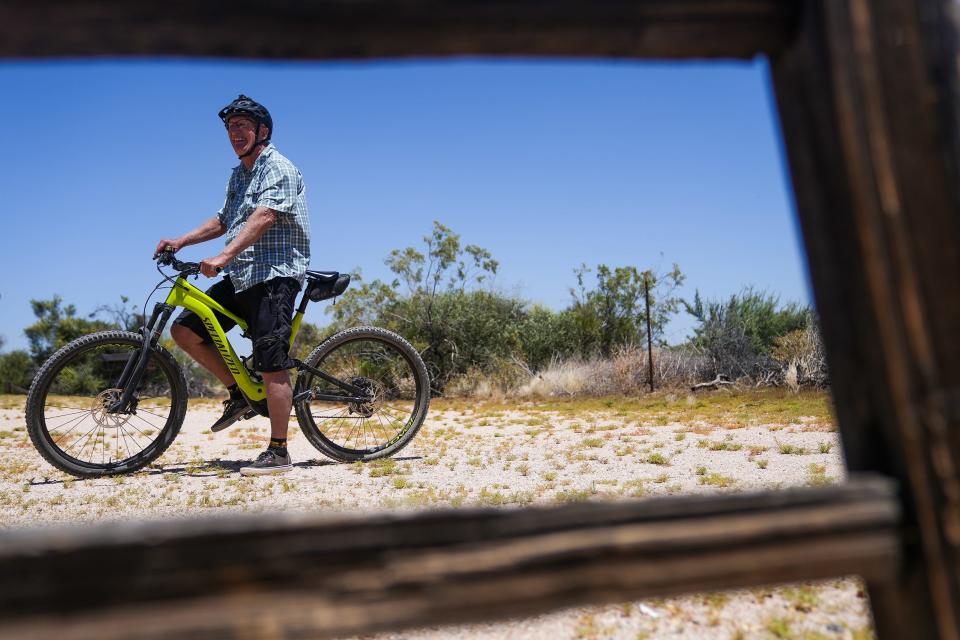
Which brings us back to Rand Hubbell.
In Arizona, the Legislature adopted a bill declaring that Class 1 and 2 bicycles are considered nonmotorized, with access to all trails where regular bikes are allowed.
A Maricopa County spokeswoman said McDowell Mountain Regional Park is "just following the law."
Yet, at the McDowell Sonoran Preserve, Hamilton used exactly the same language, saying managers are "just following the law" in prohibiting eMBTs.
How is that possible?
The statute in question turns out to be virtually meaningless. One sentence after establishing that e-bikes may ride on multiuse trails, it says local agencies are free to ignore that rule, banning battery-powered bikes from pathways.
Hubbell said it could be that the nation’s eMTB policies are varied by design. Voters created the McDowell Sonoran Preserve as an open-space conservation area, while the McDowell Mountain Regional Park was developed as a recreation site.
Different purposes, divergent rules.
In fact, there seems to be a consensus among trail users, conservationists and land managers that any blanket policy for electric bikes would prove a dismal failure. From Arizona deserts to Rocky Mountains highs, the logic goes, rules should be based on trail conditions, environmental factors, traffic volume and local politics.
Some day, Hubbell predicted, e-MTBs will be accepted wherever their analog counterparts are allowed. In the meantime, however, he carries a disability letter from his doctor when he cruises through the Sonoran Preserve on his e-bike, just in case one of the stewards challenges him.
Hubbell climbed back in the saddle and began pedaling. “I ride now more than I ever had before,” he said. “I’m 73 and don’t see any reason to stop in the next 10 years. Hopefully, longer than that.”
More from USA TODAY
More: She lost her sense of smell. It almost ended her business. How COVID, anosmia changed a life
More: From Potemkin to Putin: What a centuries-old myth reveals about Russia's war against Ukraine
More: A port city, a steel cage, a palace: The steps that made Putin 'the richest man in the world'
This article originally appeared on USA TODAY: E-bike turf war: Where electric mountain bikes are allowed, and why

